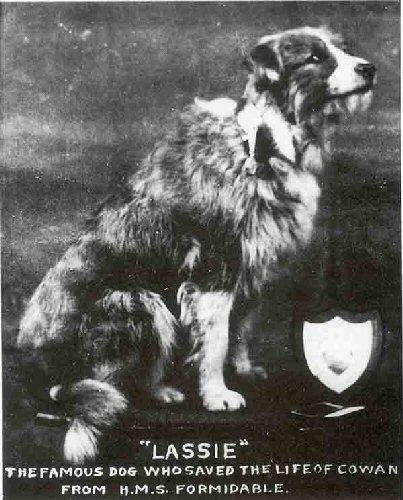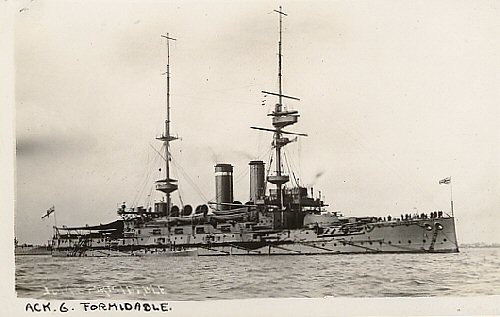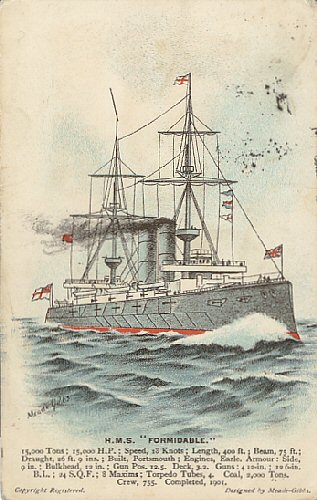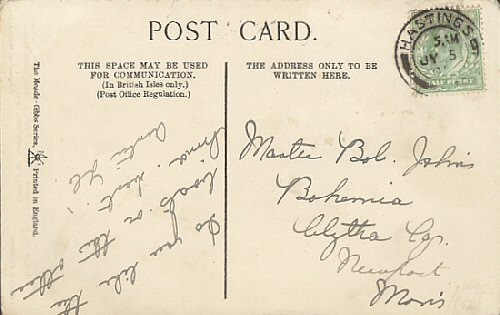
Torpedoed and sunk 1 January 1915
HMS Formidable, 15,250 tons, pre-Dreadnought Battleship, launched in 1898, first commissioned in 1901 and torpedoed by German U-boat 24 on New Year's Day 1915 while on exercises. She sank in 180 feet of water about 37 miles off the Devon coast, the first British battleship to be sunk in the First World War.
Only 199 men were saved out of a complement of about 750.
--------------------------------------------------------------------------------
HMS Formidable was sunk by two torpedoes from a German submarine 20 miles off Start Point at 2 am, 1st January 1915, in the first year of the First World War. The first torpedo hit the number one boiler port side; a second explosion caused the ship to list heavily to starboard. Huge waves thirty feet high lashed the stricken ship, with strong winds, rain and hail, sinking it in less than two hours.
Captain Loxley, his second-in-command, Commander Ballard, and the signaller stayed at their posts throughout, sending flares and rockets off at regular intervals. There was no panic, the men waiting calmly for the lifeboats to be lowered. Someone played ragtime on the piano, others sang. The Chaplain risked his life going below to find cigarettes. Suddenly the ship gave a tremendous lurch, the Captain shouted 'Lads, this is the last, all hands for themselves, and may God bless you and guide you to safety'. He then walked to the forebridge, lit a cigarette and, with his terrier Bruce on duty at his side, waited for the end, in true Royal Naval tradition.
The piano was thrown overboard: many of the boats were smashed as they were lowered into the water, killing all occupants, or else were swamped and sank. 'A piano's better than now't', said one. One pinnace with 70 men on board was picked up by the trawler Provident, 15 miles off Berry Head. The second pinnace took off another 70 men. This boat was soon half-filled with water as the men desperately bailed - with boots, caps, even a blanket, anything that came to hand. One seaman sat over a hole in the boat from the time they started away to the time of rescue. The enormous swell was terrifying, but morale was kept up by any means, humour, singing, even bullying. Petty Officer Bing admitted punching men who wanted to give up. The survivors unanimously agreed they owed their lives to Leading Seaman Carroll, coxswain, who continued to cheer and inspire, not allowing them to sink into despair. Dawn broke out of sight of land; a liner was seen, then eleven other craft, but the pounding seas and huge waves hid the pinnace. Night came, still with relentless gales.
Blackout restrictions were in force, and there are two explanations for the seamen seeing light from the shore. Petty Officer Bing saw a red light seven miles away which could have been the Lyme harbour light. The other explanation from J H Taplin, another survivor, was that a sudden bright light shone out three miles off, which may have been from the Assembly Rooms cinema. The machine had broken down and the operator examining it shone the lamp through the window for a second or two.
The pinnace was first seen at Lyme by Miss Gwen Harding and her parents walking home along Marine Parade after dining out with friends. She glimpsed the outline of a boat, her mother confirmed her suspicions and the alarm was raised. So began the rescue. Of the 71 men in the pinnace, 48 were brought ashore alive, six were found to be dead on arrival, 14 died during the 22 hours the men had fought for survival and were buried at sea, and three died after landing.
The Pilot Boat Inn (Mrs. Atkins the landlady took many survivors in. Her dog Lassie drew attention to Seaman Cowan, laid on the floor for dead, by licking his face) became rescue headquarters. Many of the townsfolk brought food and blankets. Others took men into their homes to rest and recuperate, while those needing medical aid were sent to hospital. The dead were placed in the entrance to the cinema, a part of the old Assembly Rooms.
With regards to Lassie, when the dead were carried to The Pilot Boat Inn in Lyme Regis, the landlordís dog came in and sat next to one body of a young seaman (W.S. Cowan) and started to lick his face. After sometime the sailor revived and lived to tell the tale. Lassie was awarded two animal medals.




